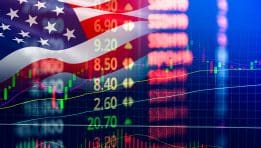The U.S. labor market has long been viewed as a cornerstone of economic strength, providing resilience even in times of uncertainty. However, recent data suggest that cracks may be emerging beneath the surface. According to the National Federation of Independent Business (NFIB), in July 2025, 11% of small business owners identified poor sales as their single most important problem. This is the highest reading since the pandemic shock of 2020, and it has doubled over the past seven months.
Historically, such sharp increases in reported sales weakness among small firms have served as a leading indicator for rising unemployment. The correlation between small business distress and labor market deterioration is particularly worrisome, given that small firms employ nearly half of the U.S. workforce. The data suggest that unemployment, which currently hovers around 4.3%, could exceed 5% in the coming months, marking a meaningful shift in the labor market narrative.
Quantitative Evidence: NFIB Data and Historical Cycles
The chart comparing unemployment with NFIB survey responses offers a clear pattern: spikes in the percentage of businesses citing poor sales often precede increases in unemployment. The early 1990s recession, the 2001 dot-com bust, the 2008 global financial crisis, and the 2020 pandemic downturn all featured this relationship.
Today, the NFIB metric has risen sharply to 11%, a level not seen since COVID-19 disruptions. The pace of the increase is striking, doubling in just seven months, which historically has signaled that consumer demand is faltering at a faster-than-expected rate. Given that consumer spending accounts for about 70% of U.S. GDP, this data point should not be overlooked.
The unemployment rate has not yet spiked, but history shows that labor markets typically lag behind business sales indicators. The NFIB’s survey suggests that the coming months may bring higher job losses as small businesses adjust to declining revenue.
Small Businesses as the Heart of Employment
The U.S. Small Business Administration reports that small firms employ roughly 62.3 million workers, accounting for 45.9% of the entire U.S. workforce. These businesses are more vulnerable to shifts in consumer demand, credit conditions, and cost pressures than large corporations, which often have more diversified revenue streams and access to capital markets.
When sales weaken, small businesses often respond quickly by cutting costs. Unfortunately, labor is one of the largest expenses, and layoffs or reduced hours become common tools of adjustment. This dynamic creates a ripple effect across the broader economy. When nearly half of the workforce is tied to businesses that are currently reporting poor sales conditions, the risk to the broader labor market cannot be ignored.
The Macro Backdrop: Why Sales Are Weakening
Several macroeconomic factors have contributed to the rise in poor sales as the top problem for small businesses.
First, consumer sentiment has weakened amid persistent inflation. While inflation has moderated from its post-pandemic highs, prices remain elevated compared to pre-2020 levels. Wage growth has not fully kept pace, eroding purchasing power for many households.
Second, interest rates remain at restrictive levels. The Federal Reserve, after a series of rate hikes in 2022–2024, has maintained a higher-for-longer stance to ensure inflation remains under control. This has raised borrowing costs for small businesses, dampening investment and expansion while also tightening credit availability for consumers.
Third, shifts in consumer behavior have added to the strain. Spending on services has remained resilient, but discretionary goods consumption has slowed. Small retailers, restaurants, and service providers—sectors heavily represented among NFIB respondents—are particularly exposed to these shifts.
Unemployment Risks: The 5% Threshold
The current unemployment rate sits just above 4%, relatively low by historical standards. However, if the NFIB signal proves as reliable as in past cycles, the U.S. is approaching an inflection point. A rise above 5% unemployment would mark a meaningful deterioration and could trigger secondary effects in financial markets and policy debates.
Markets tend to interpret rising unemployment as both a signal of weakening growth and as potential justification for looser monetary policy. However, the Federal Reserve faces a difficult balancing act. Cutting rates too soon risks reigniting inflation, while holding rates steady could exacerbate job losses.
The political implications are also significant. With the 2026 midterm elections on the horizon, rising unemployment could shape voter sentiment and policy priorities in Washington. Historically, economic downturns have played a decisive role in shaping electoral outcomes.
Historical Context and Recession Signals
The shaded areas on the chart denote NBER-defined recessions, and in nearly every case, a spike in poor sales preceded or coincided with rising unemployment. The 2008 crisis provides a particularly instructive example: small business owners began reporting weak sales well before unemployment surged into double digits.
Today’s data, though less extreme, follow a similar trajectory. The sharp doubling of poor sales concerns signals that small firms are already under pressure. If history repeats, unemployment could rise materially over the next two to three quarters.
Recession is not guaranteed, but the risk has increased. The U.S. economy remains supported by strong corporate profits in certain sectors, robust government spending, and technological investment. Yet small businesses are often the canary in the coal mine, reflecting the health of local economies and middle-class consumers more directly than large multinational corporations.
Broader Economic Implications
If unemployment does rise above 5%, the consequences will ripple across multiple dimensions of the economy.
Consumer confidence would likely decline further, reducing spending and reinforcing the slowdown in sales for small businesses. Financial markets could face volatility as investors reassess earnings expectations and the likelihood of Federal Reserve policy shifts. Government finances would also come under pressure, with higher unemployment leading to reduced tax receipts and increased demand for social safety net programs.
In addition, credit conditions for small firms could tighten further. Banks may become more cautious in lending to businesses perceived as vulnerable, exacerbating the challenges of those already struggling with weak sales. This feedback loop could accelerate the slowdown unless policymakers step in with targeted support.
Conclusion
The NFIB survey data showing 11% of small business owners citing poor sales as their most important problem is a flashing warning light for the U.S. economy. History suggests that such spikes are often followed by rising unemployment, and the risk of the jobless rate exceeding 5% in the coming months is now significant.
Small businesses, which employ nearly half of America’s workers, are struggling under the combined weight of weak demand, high borrowing costs, and shifting consumer preferences. If these pressures persist, the broader labor market will not remain insulated for long.
Policymakers, investors, and households alike should prepare for the possibility that the era of ultra-low unemployment is coming to an end. While the U.S. economy retains underlying strengths, the link between small business health and labor market outcomes cannot be ignored. When small businesses struggle, the entire economy feels it—and the data are signaling that the next phase may bring higher unemployment and increased economic uncertainty.
Comparison, examination, and analysis between investment houses
Leave your details, and an expert from our team will get back to you as soon as possible
* This article, in whole or in part, does not contain any promise of investment returns, nor does it constitute professional advice to make investments in any particular field.
To read more about the full disclaimer, click here- Lior mor
- •
- 12 Min Read
- •
- ago 1 minute
 America’s Growing National Debt: Four Decades of Expansion and Its Future Implications
America’s Growing National Debt: Four Decades of Expansion and Its Future Implications
The U.S. national debt has become one of the defining issues of modern economic policy, central to debates in Washington
- ago 1 minute
- •
- 12 Min Read
The U.S. national debt has become one of the defining issues of modern economic policy, central to debates in Washington
- orshu
- •
- 8 Min Read
- •
- ago 3 hours
 European Markets Close Mostly Lower Amid Cautious Investor Mood
European Markets Close Mostly Lower Amid Cautious Investor Mood
Stock markets finished today’s session largely in negative territory, as investors adopted a more cautious stance in response to soft
- ago 3 hours
- •
- 8 Min Read
Stock markets finished today’s session largely in negative territory, as investors adopted a more cautious stance in response to soft
- orshu
- •
- 5 Min Read
- •
- ago 4 hours
 Americas Trade Sideways as Volatility Rises and Large Caps Lose Steam
Americas Trade Sideways as Volatility Rises and Large Caps Lose Steam
The Americas markets are trading mixed today, with major indices showing limited direction amid a modest uptick in volatility and
- ago 4 hours
- •
- 5 Min Read
The Americas markets are trading mixed today, with major indices showing limited direction amid a modest uptick in volatility and
- Articles
- •
- 10 Min Read
- •
- ago 5 hours
 WALL ST FUTURES SUBDUED, FOCUS ON RETAILERS’ EARNINGS, FED SYMPOSIUM
WALL ST FUTURES SUBDUED, FOCUS ON RETAILERS’ EARNINGS, FED SYMPOSIUM
Wall Street Futures Subdued: Retail Earnings and Fed Symposium Take Center Stage Wall Street futures remain muted this week as
- ago 5 hours
- •
- 10 Min Read
Wall Street Futures Subdued: Retail Earnings and Fed Symposium Take Center Stage Wall Street futures remain muted this week as












